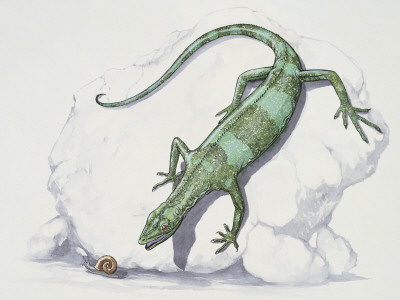[Recent Entries][Archive][Friends][User Info]
Below are the 3 most recent journal entries recorded in the "Сообщество, посвящённое ра" journal:| December 6th, 2011 | |
|---|---|
| 08:40 pm [industrialterro] [Link] |
Thadeosaurus Thadeosaurus is an extinct genus of diapsid reptile belonging to the Order Eosuchia. Fossils have been found in Madagascar, and date to the late Permian period. Thadeosaurus was a lizard-like animal, with a remarkably long tail that comprised about two thirds of the animal's total length of 60 centimetres (2.0 ft). It also had long toes, especially on the hind legs, which would have given it a powerful stride, since the toes would still touch the ground while the foot was being raised. Coupled with a strong breast bone to increase the strength in the forelimbs, this means that Thadeosaurus was probably a good runner.
Tags: Вымершие рептилии, Пермь, диапсиды, эозухии |
| 08:30 pm [industrialterro] [Link] |
Hovasaurus Hovasaurus is an extinct genus of diapsid reptile belonging to the Order Eosuchia. It lived in what is now Madagascar during the Late Permian. Hovasaurus resembled a slender lizard, and was around 50 centimetres (20 in) long, of which two thirds was taken up by its long tail. It was well adapted to an aquatic life, with the tail being laterally flattened like that of a sea snake. Some stones have been found in the abdomen of fossil Hovasaurus, indicating the creatures swallowed these for ballast, preventing them from floating to the surface when hunting fish.
Размеры тела в сравнении с человеком:
Tags: Вымершие рептилии, Пермь, диапсиды, эозухии |
| December 5th, 2011 | |
| 07:07 pm [industrialterro] [Link] |
Youngina Youngina is an extinct genus of diapsid reptile from the Late Permian Beaufort Group (Tropidostoma-Dicynodon zones) of the Karoo Red Beds of South Africa. This, and a few related forms, make up the family Younginidae, within the Order Eosuchia (proposed by Broom in 1924). Eosuchia, having become a dustbin for many probably distantly-related primitive diapsid reptiles ranging from the Late Carboniferous to the Eocene, Romer proposed that it be replaced by Younginiformes (that included Younginidae and the Tangasauridae, ranging from the Permian to the Triassic). Youngina is known from several specimens. Many of these were attributed to as separate genera and species (such as Youngoides and Youngopsis), but it was later realized that they were not distinct from Y. capensis. The holotype specimen of Youngina was described briefly in the early 20th century. The "Youngoides romeri" specimen was first attributed to Youngina, but later given its eponymous and separate designation in a later paper. Acanthotoposaurus is also a junior synonym of Youngina. Youngina was once thought to be closely related to Acerosodontosaurus, and more distantly to tangasaurids (Kenyasaurus, Hovasaurus, Thadeosaurus, and Tangasaurus), but the monophyly of younginiforms has not been demonstrated in published analyses of diapsid reptiles, and it is likely this group is paraphyletic. Acerosodontosaurus is probably closer to other former "younginiforms", rather than being closely related to Youngina. Youngina could have been a moderately sized early reptile (skull length < 7 centimetres (2.8 in)), comparable to size to some medium-sized monitor lizards such as Gould's monitor. There were likely no mobile articulations between the palate and braincase, similar to the skull of the tuatara, contrary to some earlier claims made about the metakinetic mobility of basicranial joints in Youngina and other early diapsid reptiles.
Tags: Вымершие рептилии, Пермь, диапсиды, эозухии |











